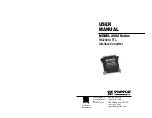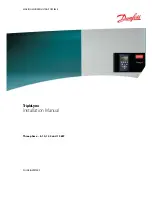
windy
nation
Revision 1
VertaMax User Manual
Page 11 of 15
4.3.2
Wire Thickness
AWG
Diameter
inches (mm)
Ohms per
1000ft
Break Force Square mm2
16
0.051 (1.29)
4.016
75 lbs
1.30
14
0.064 (1.63)
2.525
119 lbs
2.08
12
0.081 (2.05)
1.588
197 lbs
3.30
10
0.102 (2.59)
0.999
314 lbs
5.26
8
0.129 (3.26)
0.628
480 lbs
8.30
6
0.162 (4.11)
0.395
760 lbs
13.30
4
0.204 (5.19)
0.249
1210 lbs
21.15
2
0.258 (6.54)
0.156
1930 lbs
33.62
1
0.289 (7.35)
0.124
2430 lbs
42.41
0 (1/0)
0.325 (8.25)
0.098
3060 lbs
53.49
00 (2/0)
0.365 (9.27)
0.078
3860 lbs
67.43
000 (3/0)
0.410 (10.4)
0.062
4860 lbs
85.01
0000 (4/0)
0.460 (11.68)
0.049
6120 lbs
107.22
4.4 B
ATTERIES
4.4.1
Battery Life
The VertaMax can draw a significant amount of amps from your battery when operating. If you
are using it for extended periods of time, you will want to recharge occasionally to maintain the
charge in the battery. In addition, the power inverter will also draw a small current, less than
600mA, when turned off and not operating. Therefore, it should be disconnected from your
battery if it will not be used for more than a day. The following chart shows typical operation time
for typical batteries for various loads.
Power Usage
Current @ 12V
50A/h Battery Operating
Time
100A/h Battery
Operating Time
100 watt
9 Amps
5.5 hours
11 hours
200 watt
19 Amps
2.6 hours
5.2 hours
500 watt
47 Amps
1 hour
2 hours
*All Values are approximate
4.4.2
Battery State of Charge (SOC)
You can measure battery state of charge with a hydrometer or approximate state of charge with a
voltmeter. Using a digital voltmeter that can display tenths or hundredths of a volt, measure the
battery when it has not been charged or discharged for several hours.
For a deep-cycle battery at 77º F (25º C), use the following table:
Battery Voltage
State of Charge
12.7 – 13.0 V
100%
12.5 – 12.6 V
80%
12.3 – 12.4 V
60%
12.1 – 12.2 V
40%
11.9 – 12.0 V
20%
4.4.3
Actual Battery Current Draw
Approximate 12 volt current draw is the AC load in watts divided by 10. Thus a 60 watt light bulb
plugged into the inverter will cause the inverter to draw 6 amps (60 / 10 = 6) from the 12 volt
power supply (e.g. battery).
Batteries are rated in several different ways:
•
Peak cranking amps - This has little to do with how long an inverter can supply power,
so it is not a useful number for inverter operation.
•
Battery reserve capacity - This number shows how long a battery can supply a given
current, typically 25 amps, before the battery voltage reaches a low voltage. Therefore,
a battery rated at 200 minutes reserve can deliver 25 amps for 200 minutes before it is
discharged. Ampere-hour capacity - This rating indicates how many amps a battery can

































